Illuminating Spaces: Hanging Lights in India
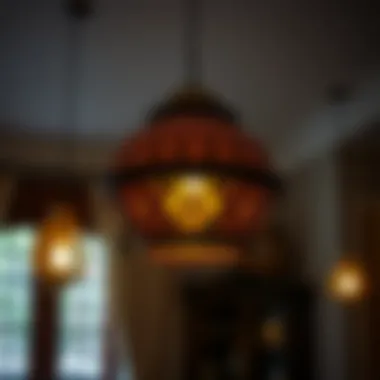
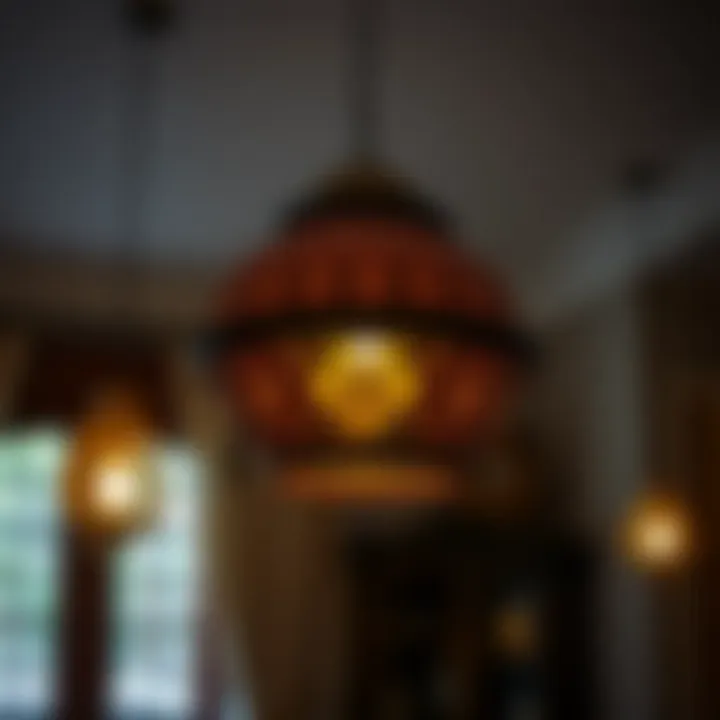
Intro
Hanging lights play a transformative role in both aesthetic appeal and functional illumination, particularly within the rich tapestry of India's interior design landscape. The options available range from traditional styles that reflect age-old craftsmanship to contemporary designs that embrace minimalism. This article aims to examine the myriad influences that shape the world of hanging lights in India, weaving together cultural significance, modern trends, and practical considerations.
As we step into the heart of this exploration, it’s clear these fixtures are not merely decorative objects; they serve as reflections of regional artistry and innovation. With diverse styles that cater to every taste and layout, selecting the right hanging light can elevate a space from ordinary to extraordinary. Let's delve deeper into the furniture design trends that influence these striking fixtures.
Cultural Significance of Hanging Lights
The world of hanging lights in India is steeped in rich traditions and cultural significance. These fixtures are more than just sources of illumination; they symbolize warmth, welcome, and aesthetics within various spaces. In myriad ways, hanging lights connect people to their heritage, reflecting a blend of artistry and functional design. The interplay between light and cultural expressions threads through festive occasions, religious ceremonies, and day-to-day life.
From ancient temples to modern homes, hanging lights illuminate pathways and hearts alike. Their presence in festivals, such as Diwali, showcases how deeply entwined they are with societal celebrations, where homes glow like beacons against the night sky. The twinkling lights signify prosperity and good fortune, effectively drawing people together to bask in the ambiance of joy and community.
Moreover, the role of hanging lights is not limited to aesthetics. They also engage in narrating stories of craftsmanship and regional identities. The designs vary across India, influenced by local materials, craftsmanship styles, and historical contexts. For instance, the intricate work of brass chandeliers in Rajasthan stands in stark contrast to the woven bamboo pendant lights of Northeast India. This diversity encapsulates the rich tapestry of Indian culture.
However, it's crucial to balance tradition with modern practicality. The evolution of hanging lights involves adapting older styles while introducing contemporary elements to suit urban living. This synergy ensures that hanging lights remain relevant, continuing to enhance the beauty of spaces while fitting into our fast-paced lifestyles. By incorporating traditional motifs into modern designs, we foster a bridge between past and present, ensuring that heritage shines brightly in homes today.
"Hanging lights not only brighten our environments but also bind our communities through shared cultural practices."
In summary, the cultural significance of hanging lights in India resonates with emotional and historical depth. They represent a balance of form and function, echoing the values of community and celebration while adapting to new dimensions of living. Understanding this cultural layer enriches the appreciation of hanging lights, transforming them from mere fixtures into carriers of tradition and sentiment.
Types of Hanging Lights
The world of hanging lights is a blend of functionality and aesthetic appeal, with various types designed to cater to different spaces and needs. Understanding the types of hanging lights available is crucial for homeowners and designers alike, as it helps to create a harmonious ambiance that complements a room's decor while fulfilling practical lighting requirements. Below, we delve into three significant types of hanging lights: chandeliers, pendant lights, and lanterns, shedding light on their unique characteristics, benefits, and considerations.
Chandeliers
Chandeliers have long been a symbol of elegance and luxury. These multi-armed fixtures often grace dining rooms and grand halls, providing a statement piece that draws the eye upwards. In India, chandeliers come in various styles, from ornate traditional designs adorned with intricate carvings to sleek contemporary models made of glass and steel.
- Key Advantages of Chandeliers:
- Visual Impact: A well-placed chandelier can become the focal point of a room, transforming the overall aesthetic.
- Versatility: Available in multiple designs and sizes, chandeliers can be suited for different spaces, whether it's a cozy home setting or a sprawling banquet hall.
However, one must consider the height of the ceiling and the scale of the room when selecting a chandelier. A bulky chandelier in a small space can feel overpowering, while a delicate design might get lost in an expansive area. Furthermore, these fixtures often require substantial maintenance, as dust accretion can diminish their luster.
Pendant Lights
Pendant lights represent a fantastic blend of style and functionality. They often come down from the ceiling by a cord or chain, making them perfect for hanging over kitchen islands, dining tables, or even in clusters to provide varied lighting.
- Benefits of Pendant Lights:
- Spatial Definition: Pendant lights can help delineate spaces in open-plan areas, creating cozy nooks where conversation can flourish.
- Design Diversity: From sleek modern styles to handcrafted artisanal creations, pendant lights offer a myriad of designs that can match any decor theme.
When choosing pendant lights, consider their height and spacing. A single pendant light can be very effective in small spaces, while a group of pendants can create a stunning visual effect when arranged correctly. Additionally, these lights should be easy to reach for bulb changes and cleaning.
Lanterns
Lanterns, both indoor and outdoor, have a unique charm that speaks to warmth and tradition. In India, they come in various styles, including traditional oil lanterns with intricate metalwork and modern electric versions made of sleek designs. They serve as excellent mood lighting, particularly in outdoor settings.
- Pros of Lanterns:
- Cultural Significance: Lanterns can often carry cultural importance, celebrating festivals like Diwali, where they play a prominent role in decoration.
- Flexibility: Whether hung in a garden, patio, or even inside a living room, lanterns add a cozy atmosphere, inviting warmth and togetherness.
However, their light output may not be as strong as other hanging lights, making them better suited for ambient lighting rather than task lighting. Therefore, it is key to integrate them with other lighting sources for a well-rounded illumination scheme.
Whether you opt for the grandeur of a chandelier, the modern sleekness of pendant lights, or the nostalgic touch of lanterns, understanding the types of hanging lights available can enable you to make informed decisions that elevate your home's character.
Materials Used in Hanging Lights
The choice of materials in hanging lights not only determines their durability but also their aesthetic appeal. The materials used lay the groundwork for how a light fixture will perform, its weight, its maintenance needs, and ultimately the ambiance it creates in a space. In India, where both traditional and contemporary designs coexist, selecting the right material can make a world of difference in how well the hanging lights mesh with the surrounding decor.
Metal Fixtures
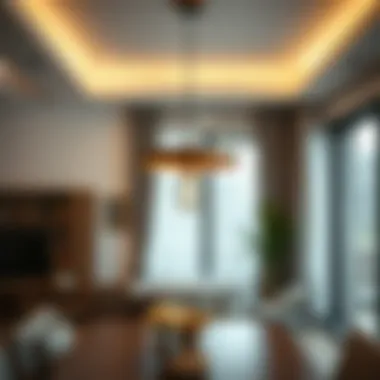
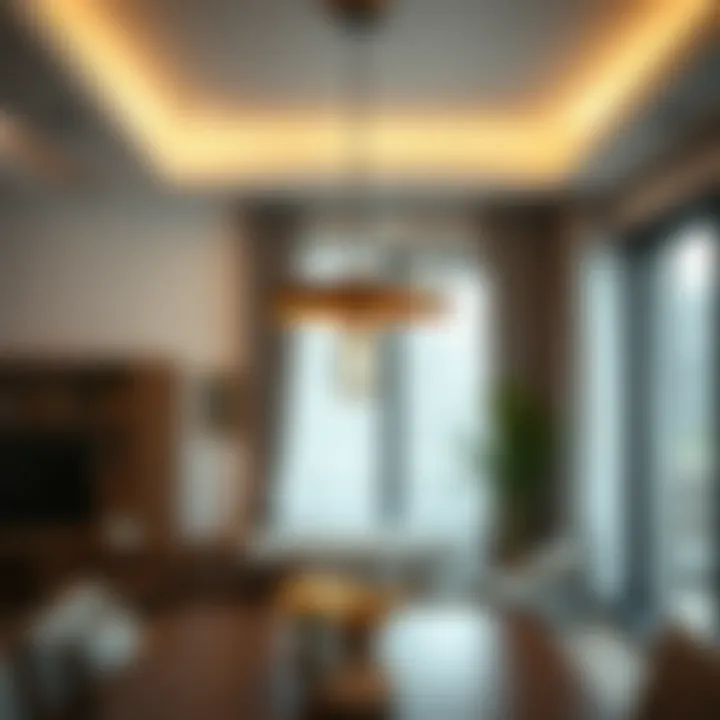
Brass
Brass is a classic material, and it carries an elegance that is hard to beat. With its rich golden hue, brass adds a touch of luxury to any fixture it adorns. One key characteristic of brass is its durability; it resists corrosion and tarnish, making it a worthwhile investment for long-lasting decor items. For this article, when focusing on hanging lights, brass is particularly popular due to its ability to be intricately detailed, often seen in ornate chandeliers or vintage-style pendants.
A unique feature of brass is its ability to develop a patina over time. This natural aging process can result in a beautiful and unique finish that many designers seek out. However, one disadvantage may be its heavier weight compared to other materials, which can necessitate stronger mounting solutions.
Aluminum
Aluminum stands out as a lightweight and malleable option, making it versatile for various designs. Its resistance to rust and corrosion makes it suitable for both indoor and outdoor use. Aluminum's lightweight nature allows for easy installation, especially in fixtures that hang from a ceiling. This factors into why it's often a favorite among designers looking to create sleek and modern hanging lights.
Another important characteristic is the ability to anodize aluminum, which can enhance its color and finish. While this can add flair to a design, one potential drawback is that anodized finishes might show scratches more easily than other materials.
Glass Elements
Crystal
Crystal lighting fixtures can transform a simple room into an extravagant space. The refractive quality of cut crystal disperses light beautifully, creating stunning reflections and adding depth to lighting schemes. In the context of hanging lights, crystal often symbolizes opulence and is frequently used in grand chandeliers that grace formal dining areas or luxurious hotel lobbies.
The key advantage of using crystal is its timeless elegance, but it isn’t without its flaws. Crystal fixtures can be quite heavy and more challenging to install, and they often require delicate cleaning to maintain that sparkling aesthetic.
Frosted Glass
Frosted glass offers a beautiful balance between elegance and practicality. The diffusion of light through frosted glass provides a soft glow, creating cozy atmospheres in spaces like bedrooms or living rooms. This makes it a popular choice for pendant lighting, where a warm ambience is key. A notable feature of frosted glass is its ability to reduce glare, ensuring that the light is comforting rather than harsh.
However, one downside might include its sturdiness. While it’s generally not fragile, frosted glass can be more susceptible to chips and scratches, which can detract from its visual appeal over time.
Natural Materials
Bamboo
Bamboo is a unique option that draws upon nature to bring warmth and texture into home environments. This sustainable material is not only lightweight but also offers flexibility in design, allowing for organic shapes that can complement both rustic and modern aesthetics. The significance of bamboo lies in its ecological benefits as a renewable resource, making it an excellent choice for eco-conscious consumers looking to create a harmonious blend with nature.
While bamboo is generally quite strong, its susceptibility to water can be a concern in humid environments. Careful placement and maintenance can mitigate these issues.
Wood
Wood offers a classic and timeless option for lighting fixtures. Each piece is unique, providing variations in grain and texture that add character to hanging light designs. A key selling point for wood is its ability to easily integrate with various decor styles, from traditional to contemporary.
But, while wood possesses undeniable charm, it does require regular maintenance to prevent warping and damage over time. Depending on the type, it can also be relatively heavy, influencing installation methods.
Design Trends in Hanging Lights
Hanging lights have transformed from mere fixtures to pivotal elements of interior and exterior design, influencing the ambiance and functionality of spaces. The design trends in hanging lights represent the evolving tastes and technological advancements that define contemporary decor. These trends not only showcase aesthetic preferences but also integrate practical considerations, helping homeowners and designers to strategically select lighting that complements their vision.
Minimalist Aesthetics
Minimalism in design emphasizes simplicity and functionality. When it comes to hanging lights, this trend is marked by clean lines, simple shapes, and a reduced color palette. Choosing minimalist light fixtures often results in spaces that feel more open and uncluttered, helping to create a serene environment. The beauty of minimalist aesthetics lies in its ability to allow other design elements—such as furniture and artwork—to shine without distraction.
For instance, a sleek black metal pendant lamp can serve as a stunning focal point without overwhelming a modern, neutral-toned kitchen. This approach embraces negative space and is ideal for homeowners looking to combine style with practicality. Moreover, minimalist designs usually involve energy-efficient options, offering both aesthetic appeal and sustainability.
Vintage Revivals
The resurgence of vintage design in hanging lights reflects a broader nostalgia for classic styles. Vintage fixtures often evoke a sense of story and heritage, appealing to those who wish to incorporate history into their living spaces. This trend captures various eras, from the ornate chandeliers of the Victorian age to the rustic charm of mid-century designs.
Selecting vintage-inspired hanging lights can make a bold statement, drawing the eye and sparking conversation. Think about incorporating a bronze or brass chandelier that nods to an art deco aesthetic while harmonizing with modern decor. These pieces can bring warmth and character to more utilitarian spaces, providing a connection to the past amidst contemporary living.
As homeowners seek to personalize their environments, vintage revivals offer endless combinations that blend old-world charm with new styles, creating a unique ambient experience.
Eco-Friendly Designs
As awareness of environmental issues grows, eco-friendly designs in hanging lights have gained traction. This trend encompasses a range of practices—from using sustainable materials such as reclaimed wood or recycled glass to integrating energy-efficient lighting options like LED bulbs. The push towards sustainability is prompting designers to rethink how lighting fixtures are crafted and how they influence our ecological footprint.
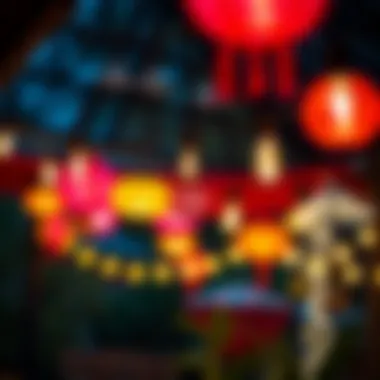
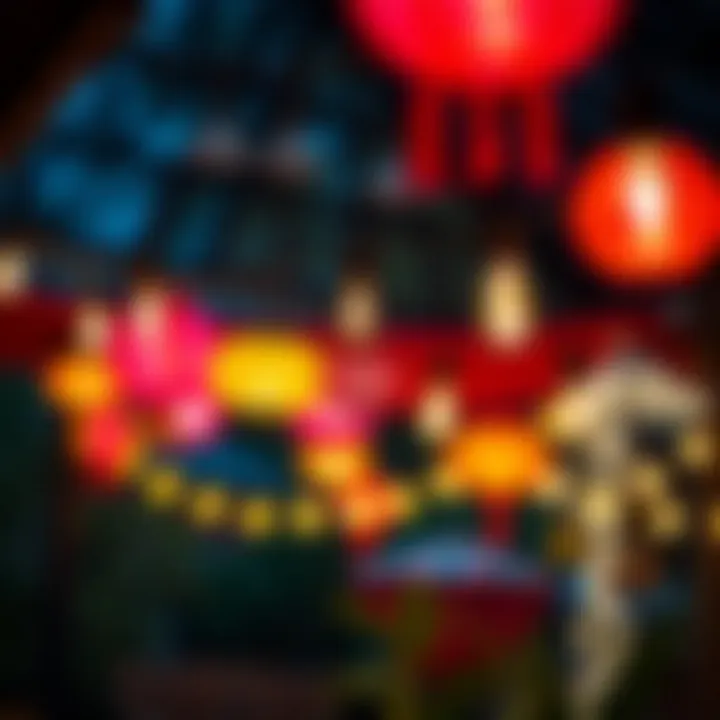
Eco-friendly hanging lights not only help reduce energy consumption but also contribute to a healthier living environment. An example could include a pendant made from bamboo and featuring a simple LED element, providing a warm glow while exemplifying a commitment to environmental stewardship. These designs often reflect an understanding of natural aesthetics, encouraging a connection between the indoors and the surrounding environment.
In summary, the design trends in hanging lights today cater to a diverse range of tastes and values. From advancements in minimalist aesthetics that prioritize clean elegance to the nostalgic charms of vintage revivals and the emerging importance of eco-friendly practices, these trends help shape not just how we illuminate our spaces but also how we view the relationship between design and our everyday lives.
"Lighting is the skeleton of design; without it, a room feels lifeless."
By keeping up with these trends, homeowners and designers can ensure they select hanging lights that not only enhance the beauty of their spaces but also resonate with their values and lifestyles.
Key Considerations for Choosing Hanging Lights
When it comes to choosing hanging lights, several essential factors can influence the final decision. These lights do more than just brighten up a room; their aesthetic appeal, the ambiance they create, and their compatibility with existing decor make them a significant element in interior design. Choosing the right hanging lights can elevate a space from meh to marvelous, offering both practical benefits and visual enhancement. Here are some vital considerations that one should keep in mind.
Room Size and Ceiling Height
One of the first things to consider is the size of the room and the height of the ceiling. A too-large chandelier in a small room can feel overwhelming, while tiny pendants in a spacious living area may become lost in the vastness. The general rule of thumb is to hang the fixture about 30 to 36 inches above a dining table or counter and adjust the height accordingly for higher ceilings. For particularly high ceilings, a longer fixture or multiple drops can provide a sense of balance and elegance to the space. Moreover, the scale of the light should match the rooms dimensions, creating harmony instead of chaos.
Light Output and Type
Warm Light vs. Cool Light
Choosing between warm light and cool light can drastically affect the atmosphere of a space. Warm light creates a cozy and inviting feel, akin to the glow of a sunset, making it an excellent choice for areas where relaxation is the goal, like living rooms or bedrooms. On the other hand, cool light, typically around 4000K to 5000K, mimics daylight and is invigorating, making it ideal for places like kitchens or home offices where clarity of vision is essential.
The unique feature of warm light often lies in its ability to soften the ambiance, promoting a tranquil environment. Many people find it beneficial for evening settings, as it settles them down after a long day. Conversely, cool light comes with its distinct set of advantages; it enhances concentration and visibility — great for detailed tasks. Thus, your choice depends on the feel you wish to achieve in the area.
Adjustable Brightness
Adjustable brightness is another fantastic feature to consider in hanging lights. This capability allows you to modify the light output according to the mood you wish to create, giving you full control over your environment. Whether it's a peaceful dinner setting or a lively gathering with friends, adjustable brightness lends versatility that static options simply can't provide.
By using dimmable LEDs or smart lighting systems, you can tailor the intensity and ambiance of a room with just a flick of a switch or a tap on your smartphone. This feature not only enhances user experience but also conserves energy, making it a practical and environmentally friendly choice.
Style Integration
Matching with Decor Themes
Every room has its own flavor, and the hangin lights chosen should complement that flavor rather than clash with it. Matching the style of hanging lights with your decor themes is critical. For instance, industrial-style lights can work brilliantly in a loft or modern setting, giving a rugged yet chic vibe. In contrast, ornate chandeliers fit snugly in traditional or vintage interiors, exuding timeless elegance.
Finding a match creates a cohesive look, pulling all elements of a space together. This integration can serve as a conversation starter, showcasing personal style and creativity. However, care should be taken not to overcrowd the space with decorative elements that compete for attention.
Color Schemes
Color schemes play a pivotal role in how hanging lights are perceived within a space. Choosing lights that echo existing colors or introduce a pop of contrasting hues can effectively enhance the overall aesthetic. For example, a muted palette can benefit from a striking pendant light in vibrant blue, creating a focal point that draws the eye. Conversely, neutral lights can seamlessly blend into an already colorful environment, creating balance.
The unique advantage of considering color schemes is that they allow room for experimentation while ensuring the lighting doesn’t detract from or overwhelm the decor. Differentiating shades, tones, and finishes can transform an ordinary setting into something extraordinary. Hence, aligning colors with the decor is not just a choice—it's a strategy for elevating the ambiance of your spaces.
Choosing the right hanging lights involves thoughtfulness and careful consideration. Whether its functionality or aesthetics, striking a balance between these factors can be the key to achieving stunning and practical results.
Installation and Maintenance
The installation and maintenance of hanging lights is a cornerstone topic when discussing their role in both indoor and outdoor spaces. Not only does proper installation ensure safety and functionality, but it also plays a critical part in accentuating the design and feel of a given area. Homeowners and designers alike need to keep in mind that neglecting these aspects can lead to poor lighting performance and, in the worst cases, hazardous situations. Therefore, exploring the nuances of installation procedures and maintenance practices is essential for optimizing the use of hanging lights.
Professional Installation
When it comes to hanging lights, professional installation is often the gold standard. While the idea of a DIY approach may seem tempting, the intricacies involved in securing these fixtures safely to ceilings, especially in large spaces, requires expertise. A professional installer not only has the experience but also understands the local electrical codes which can minimize potential issues down the road.
Consider the example of chandelier installation; it may appear simple on the surface, yet a slight miscalculation in weight distribution can lead to disastrous consequences. Thus, hiring someone skilled in this area often saves a great headache later. Moreover, professionals will usually provide warranties for their work, giving added peace of mind.
Maintenance Practices
Cleaning Techniques
Keeping hanging lights clean is more than just a matter of appearance; it also affects their brightness and longevity. Dust and grime can accumulate, dulling the sheen of materials such as crystal or metal. A popular technique for cleaning glass components is to use a solution of warm water mixed with white vinegar. This combination not only removes residue but also leaves behind a streak-free shine that highlights the craftsmanship of the light fixture.
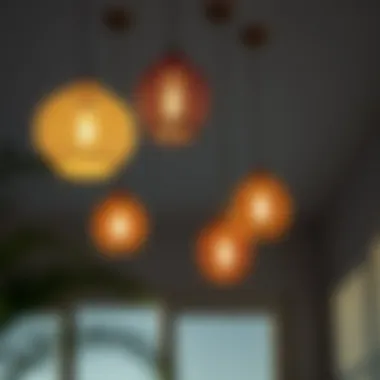
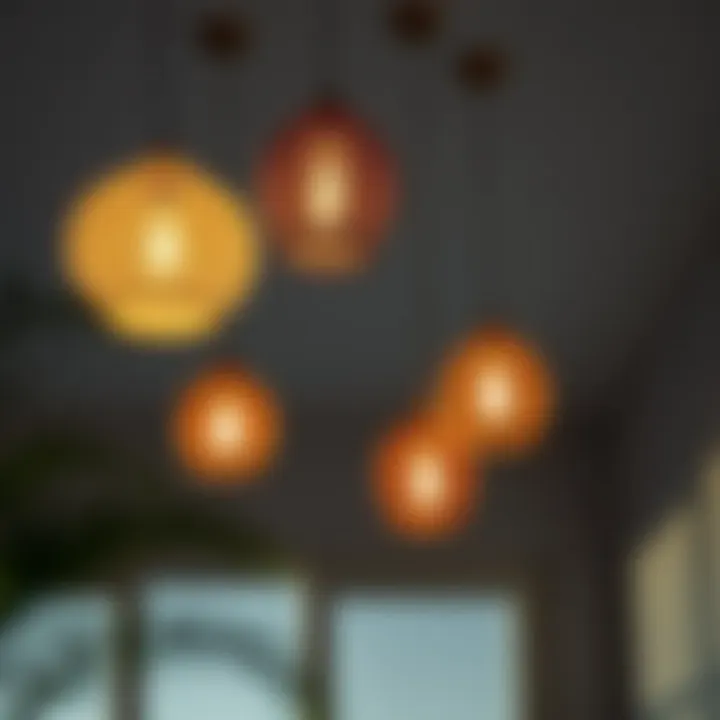
One unique feature of this cleaning method is its practicality for homeowners—it's both easy and cost-effective. Yet, it is essential to handle delicate fixtures with care, as dropping parts can result in costly damage. This simple practice of regular cleaning can significantly enhance the functional life of a hanging light and maintain its aesthetic appeal over time.
Safety Precautions
In any installation or maintenance routine, safety precautions should never be overlooked. Turning off the power supply before starting any work is a must. Furthermore, using insulated tools minimizes the risk of electrical shock. One notable characteristic of safety measures is that they foster a healthier environment for both the installer and the inhabitants of the space.
It’s wise to assess the structure where hanging lights are installed. For instance, checking that the anchors and fastenings can bear the weight of the light fixture is critical. Ignoring these details can lead to failures that might not be immediately apparent but could have dire consequences later.
Epilogue
In summary, careful attention to both the installation and maintenance of hanging lights can make a world of difference. Not only do they brighten spaces but they also contribute to overall decor aesthetics. Ensuring that these fixtures are properly installed by a professional and maintained with straightforward practices will keep them looking their best while safeguarding your home and family from potential risks.
Hanging Lights in Outdoor Spaces
Creating inviting outdoor spaces is often about the fine details. Hanging lights not only illuminate these areas but also enhance their aesthetic appeal significantly. Outdoor hanging lights offer a harmonious blend of function and beauty, allowing spaces like gardens, patios, and balconies to become extensions of the home, especially during the evening hours.
The significance of outdoor lighting cannot be overstated. It brings about a sense of safety, ensuring that paths and areas remain visible after dark, and allows for outdoor activities to linger longer into the night. Moreover, strategic placement of hanging lights can effectively create a warm ambiance ideal for gatherings and quiet nights under the stars, making the outdoors feel more welcoming.
When considering hanging lights for outdoor spaces, there are a number of specific elements and benefits to keep in mind:
- Weather Resistance: Outdoor lights should be built to withstand elements like rain and intense sunlight. Opting for fixtures rated for outdoor use ensures longevity.
- Energy Efficiency: With advancements in LED technology, energy-efficient lights can provide excellent brightness without running up that electricity bill.
- Style Variety: These lights come in various styles, from rustic lanterns to sleek modern designs, matching the individualized taste of homeowners and complementing the outdoor decor.
- Versatility: Whether it’s a garden cocktail party or a quiet family dinner, the right hanging light fixtures can radically transform the mood.
Lighting choices also affect how one navigates these spaces. Well-placed fixtures can guide guests along a pathway while providing an intimate setting without overwhelming brightness. Therefore, selecting the appropriate hanging lights is critical for both design and functionality.
Garden and Patio Lights
Garden and patio lights significantly enhance outdoor living spaces, transforming ordinary environments into enchanting escapes. These lights play a pivotal role not just in functional illumination but in creating a captivating atmosphere. Depending on style and intensity, they can be used for any purpose, from showcasing landscaping features to inviting relaxation and warmth.
Using hanging lights in gardens often adds a whimsical and ethereal touch. Fairy lights draped between trees or vintage lanterns hanging from hooks create a dreamy scene that can transport onlookers to another place. Meanwhile, patio lights, particularly those designed to hang above dining areas, provide just the right kind of brightness for evening meals.
To maximize impact, consider:
- Layering Light: Combining different types of outdoor lights like spotlights, path lights, and hanging fixtures creates dimension.
- Focal Points: Direct attention to your favorite features, such as unique trees or sculptures, by strategically placing hanging lights nearby.
- Adjustable Options: Pendants or lights with adjustable lengths cater to different ceiling heights, ensuring that every setting can be adequately illuminated.
Festive Lighting Options
Outdoor hanging lights aren't just for everyday use; they play a starring role during festive occasions. Celebrations such as Diwali, Christmas, or local festivals often encourage extensive usage of decorative outdoor lighting. They enhance visual enjoyment and help in representing cultural significance.
Consider the vibrancy of Diwali when homes are adorned with an array of lights. For many homeowners, it’s a tradition to drape colorful lights along pathways or hang them from trees, creating a festival of lights that resonates with joy and energy.
Key points to consider for festive lighting include:
- Color Choices: Select shades that resonate with the celebration, as certain colors can evoke specific moods and emotions.
- Light Designs: Choose unique designs, such as star-shaped or floral-patterned fixtures, which can add a playful touch to the festive atmosphere.
- Easily Installable Options: Using battery-operated lights or solar-powered fixtures simplifies the installation process, making it easy to set up stunning displays without getting tangled in electric cords.
"A well-lit space not only enhances aesthetics but also draws people together, creating memorable moments worth cherishing."
The Future of Hanging Lights in India
As we look ahead in the realm of decor, hanging lights in India are poised to undergo significant transformations. These changes stem from a blend of technological advancements and a growing inclination towards sustainable practices. Understanding the evolving nature of these fixtures not only helps homeowners and designers stay ahead of the curve but also ensures that our homes align with modern values of efficiency and environmental consciousness.
Technological Innovations
The landscape of hanging lights is rapidly evolving, thanks to breakthroughs in technology. Smart lighting solutions, for instance, are revolutionizing how we use and interact with light. Many contemporary hanging lights now integrate smart systems that allow users to control brightness, color, and schedules via mobile applications. This feature is not just about convenience; it also empowers homeowners to create the right atmosphere for any occasion. Imagine dimming the lights with a simple tap on your smartphone or altering their hue to match your mood!
Moreover, advancements in LED technology have replaced traditional bulbs, significantly reducing energy consumption. LED lights are available in various styles and can last up to 25 times longer than incandescent bulbs. This longevity not only makes them a cost-effective choice but also contributes to a decrease in electronic waste.
Modular designs are also emerging, where hanging lights can be customized or reconfigured based on changing aesthetic preferences or spatial requirements. By blending artistry with functionality, these designs cater to a fulfilling experience, creating twinkling canopies that adapt to both inside and outside settings.
"Innovations in hanging lights are not just about lighting a space; they are about creating a dynamic and responsive environment that reflects contemporary living."
Sustainability and Eco-Conscious Trends
In an age where sustainability matters more than ever, the future of hanging lights in India mirrors the global shift towards eco-friendliness. More consumers are seeking out fixtures made from recycled materials or those that adhere to ethical production practices. Wood, bamboo, and rattan are increasingly favored for their organic appeal and renewability. These materials evoke a sense of earthy elegance while minimizing carbon footprints.
The impact of sustainability goes beyond just the materials used. Integrating solar-powered hanging lights into gardens and outdoor spaces is gaining traction. These innovative designs harness natural sunlight, converting it into energy that lights up your outdoors without relying much on electricity. This trend not only reduces energy costs but also promotes the use of clean, renewable energy sources.
Furthermore, companies are focusing on systems of production that prioritize environmental health. Sourcing raw materials responsibly and ensuring energy-efficient manufacturing processes are becoming crucial factors in the industry. Consumers are now willing to invest in high-quality and sustainable products, understanding that their choices can contribute to larger environmental goals.
As we look forward to the future, the choices we make regarding hanging lights will likely reflect a broader understanding of our ecological responsibilities, shaping homes that are not only beautiful but also sustainable.



